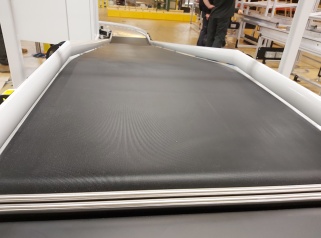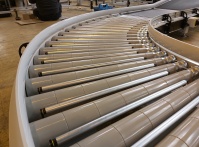The two most common types of conveyors are belt conveyors and roller conveyors. Both types of conveyor include a number of variations - such as powered or gravity rollers and conventional belt or plastic modular belt - but in general, these are the most common types of conveyor available.
Why would you use one over the other?
The reasons almost always come down to the required functionality and the product being conveyed.
Both types of conveyor can be used to transport product, act as sortation systems and to accumulate.
When to use belt conveyors?
- Product suitability - typically loads such as bags, small components and anything with an irregular/non-flat bottom are not suitable for use on roller
 conveyor. Belt conveyors are much more versatile when it comes to the type of product you can convey. An example of this can be seen in our Buffer Conveyor System case study here. Ordinarily, we would have used a pallet roller conveyor for a project such as this, but due to the fact that the product was in bags/sacks, they were much more suited to travelling on modular belt conveyors.
conveyor. Belt conveyors are much more versatile when it comes to the type of product you can convey. An example of this can be seen in our Buffer Conveyor System case study here. Ordinarily, we would have used a pallet roller conveyor for a project such as this, but due to the fact that the product was in bags/sacks, they were much more suited to travelling on modular belt conveyors. - Inclined conveying - in general rollers are not ideal for transporting goods up an incline, although we have developed our SmartLine™ tote conveyor to carry totes up inclines. Generally, belt conveyors, lifts or spirals are perfectly suited to inline transportation.
- Cost - typically a belt conveyor will be a cheaper solution than a powered roller conveyor. Being lightweight, small product belt conveyors are ideal for transportation.
When to use roller conveyors?
- Accumulation - rollers are ideal for creating conveyor systems capable of
 accumulating your product. Zero-Line Pressure roller conveyors, in particular, can accumulate product without them ever coming into contact with each other.
accumulating your product. Zero-Line Pressure roller conveyors, in particular, can accumulate product without them ever coming into contact with each other. - Additional functionality - roller conveyors are ideal for adding additional functionality to conveyor systems. Things like pneumatic stops, diverts, merges, scanners that need to see the underside of a product, etc., are all easily added to roller conveyors.
- Human Interaction - roller conveyors can be easier to deal with when operators need to push, pull, rotate or remove product due to their lower coefficient of friction than most belts.
Conclusion
Your conveyor requirements will very much depend on the desired application, product, and factory layout. In many cases, conveyor systems will be a mix of belts and rollers at different points to create the maximum product control and most efficient flow.
Advance is always available to assist with the specification and design process. Contact us today on 01325 328 930, email: sales@advanceautomation.co.uk.
Published: 28th January 2020
